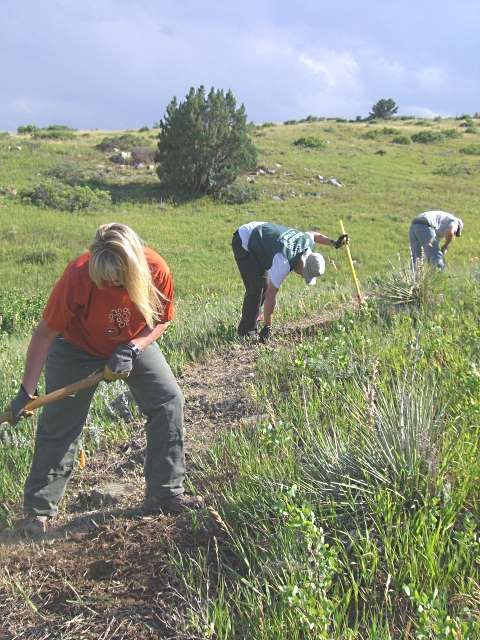Trail Maintenance Explained#
Learn about City of Fort Collins Natural Areas trail work.
Natural Areas Trail Maintenance Goals#

- Improve trail durability for high use
- Repair trail damage
- Create more sustainable trails
- Restore natural drainage patterns
- Reduce or eliminate erosion
- Enhance visitor safety
- Reduce the duration or incidents of trail closure due to wet and muddy conditions
Natural Areas Trails staff continually maintain trail conditions throughout the year. This includes tasks like removing vegetation from the trail’s corridor, improving drainage and durability of the trail’s surface, and eliminating or repairing various hazards encountered along the trail. Over 45 miles of trail are maintained each year by a small team of staff, volunteers, and contractors.
Frequently Asked Questions#
-
Trail routing is a collaborative, intentional process that carefully considers many factors when designing trails that are ecologically, socially and fiscally sustainable. Factors include sensitive wildlife habitat, threatened plant communities, archaeological and cultural resources, soil type, watershed, topography and visitor experience. The process is led by the land management agency and can often involve other agencies, conservation partners, neighboring landowners and various stakeholders who represent different use types.
-
The City of Fort Collins Natural Areas Department (NAD) predominantly builds multi-use trails. However, some trails managed by NAD are designated as use-specific. Certain design techniques related to trail structures, corridor height and width, and degree of challenge are built into these trails to optimize visitor experience. There are also often differences in trail construction related to whether a trail is built in a front-country or a back-country setting; these include aspects such as trail width, grade and allowed obstructions. Visitors have varying levels of ability and desire different types of trail experiences; NAD endeavors to provide a variety of trail opportunities to meet their needs.
-
Much like your backyard garden’s soil, the soil of a trail often benefits from an amendment. The soils of Colorado's Front Range are predominantly clay. Clay is a wonderful soil for trail surfaces when it is dry. However, when it becomes wet it is incredibly vulnerable to damage, especially on well-loved and often-visited natural area trails. In an effort to increase visitor days, and decrease trail closures, amendments are added to the surface of clay trails.
The amendment helps create a more heterogenous (uniform) soil composition that both improves trail durability and drainage. Trail amendments also help promote narrower trails and ecological integrity. When the trail is not muddy, visitors do not need to trample the vegetated edges in search of a dry spot.
-
Trails are often designed to take visitors exactly where they would like to go in the most efficient and sustainable way possible – for example, to a popular fishing spot, a favorite climbing area or a scenic vista. However, trails are also designed to avoid hazards, sensitive plant and wildlife communities, and irreplaceable cultural and archaeological resources. When visitors travel off trail, they threaten these resources, which serve as conservation priorities for the land manager.
When enough people walk off trail, it can create a new, undesignated trail. These trails, often referred to as “social trails,” pose a management challenge to land managers.
When visitors create undesignated, "social" trails, they can impact sensitive wildlife habitat and plant communities – and this alters the ecological integrity of an area. Social trails may also affect the protection of cultural and archaeological resources through disturbance, destruction or collection. Further, when open space agencies with limited resources need to manage social trails (for example, inventorying or restoring them), they have less time for maintaining or constructing designated trails and conserving publicly protected spaces.
-
As visitation intensifies, trails will typically expand in width and may experience “braiding.” This creates the challenging management decision to either maintain multiple trails within the same corridor, or maintain a wider trail. Some users are opposed to wider “two-track” trails, but it can be nearly impossible to maintain a “single-track” profile on a heavily visited trail. Therefore, City of Fort Collins Natural Areas Department (NAD) attempts to provide a variety of both wider “two-track” and “single-track” experiences for visitors throughout its 110-mile trail system.
NAD has closed and realigned heavily used trails in the past. However, while visitation was a factor in the decision-making process, the trail closures were related more specifically to issues of sustainability. After realignment was complete, the old trails were closed with large boulders and waddles to reduce erosion, and then reseeded with a native plant mixture. These closures have been successful, as the newly realigned trails were designed to provide a better visitor experience and improved sustainability.
-
City of Fort Collins Natural Areas Department implements "wet and muddy” trail closures on some natural areas when trail conditions are particularly vulnerable. This includes closing access at all entry points to a property with gates and signage. Trail closures are reported through a variety of web-based and social media resources, so that visitors may plan ahead and prepare for their trail experience. Closures are also patrolled by law enforcement personnel (Rangers).
In instances when a natural area is not closed due to vulnerable trail conditions, and a visitor encounters a muddy section of trail, they are advised to go through the mud. Attempting to avoid the mud by walking off trail to find a drier travel path tramples sensitive vegetation and widens trails. This affects visitor experience and creates trail maintenance issues for a wider trail or two or more “braided” trails. If visitors do not care to deal with mud, they are advised to stay home or visit one of the paved trails.
-
When it is icy, as with mud, visitors are advised to go through the ice, and to avoid walking off trail. Visitors should plan ahead and prepare for icy conditions by bringing traction devices for their boots and hiking staffs. Many land management agencies now have web-based trail reporting resources that can alert and inform visitors of trail conditions before heading out on their adventure.